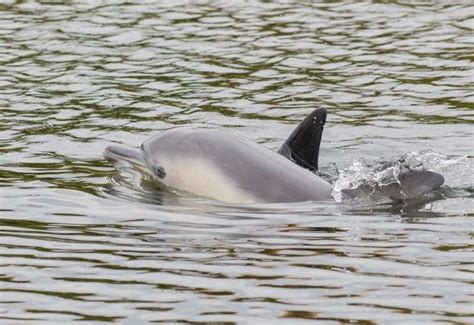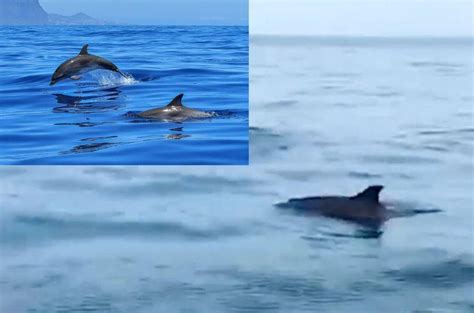
Dolphins have been sighted in inland waterways, prompting authorities to issue warnings urging the public to maintain a safe distance from the marine mammals. The unusual sightings have raised concerns about the dolphins’ well-being and the potential dangers of human interaction.
Authorities are cautioning residents to observe the dolphins from afar and avoid any attempts to feed or interact with them. According to officials, approaching or feeding the dolphins can disrupt their natural behavior, making them dependent on humans and potentially endangering both the animals and people. The specific locations of the sightings have not been officially disclosed to prevent attracting crowds and further disturbing the dolphins.
The presence of dolphins so far inland is an uncommon occurrence, leading marine biologists to speculate on the reasons behind their straying from their typical coastal habitats. While the exact cause remains under investigation, possibilities include disorientation due to strong currents, pursuit of prey, or underlying health issues affecting the dolphins’ navigation abilities.
“It’s important to remember that these are wild animals, and we need to give them space,” stated a spokesperson for the local marine wildlife agency. “Approaching or feeding them can alter their natural behavior and put them at risk.” The agency is working with experts to monitor the dolphins’ movements and assess their condition. They are also prepared to intervene if the dolphins appear to be in distress or unable to return to the ocean on their own.
The sightings have sparked considerable interest among local residents, with many eager to catch a glimpse of the marine mammals. However, authorities are emphasizing the need for responsible observation and adherence to guidelines to ensure the dolphins’ safety and well-being. Residents are encouraged to report any sightings to the marine wildlife agency but to refrain from approaching the animals themselves.
The unusual presence of dolphins in inland waterways underscores the importance of protecting marine environments and understanding the complex factors that can influence animal behavior. Authorities are urging the public to cooperate with efforts to monitor and safeguard the dolphins, allowing them the best chance to return to their natural habitat safely. This incident serves as a reminder of the delicate balance between human interaction and wildlife conservation, highlighting the need for responsible stewardship of marine resources.
Expanded Coverage and Background Information
The recent sightings of dolphins inland are not entirely unprecedented, although they remain relatively rare occurrences. Marine biologists note that dolphins, particularly bottlenose dolphins, are known for their adaptability and can sometimes venture into rivers and estuaries in search of food or to escape predators. However, prolonged stays in freshwater environments can pose health risks to dolphins, as their bodies are adapted to saltwater.
The specific reasons why these particular dolphins have strayed so far inland are still being investigated, but several factors could be at play. One possibility is that the dolphins were following a school of fish that swam into the river or estuary. Dolphins are highly intelligent and opportunistic hunters, and they will often pursue prey wherever it leads them.
Another possibility is that the dolphins became disoriented due to strong currents or unusual weather conditions. Storms and tidal surges can sometimes push marine animals into unexpected areas, and it can be difficult for them to find their way back to the open ocean.
A third possibility is that the dolphins are suffering from some kind of health problem that is affecting their navigation abilities. Dolphins rely on echolocation to navigate and find food, and any impairment of this sense could make it difficult for them to stay on course.
Regardless of the cause, the presence of dolphins in inland waterways raises concerns about their well-being. Freshwater environments can be stressful for dolphins, and they may not be able to find the food they need to survive. They are also at risk of being exposed to pollutants and other hazards that are more common in inland waters.
Authorities are taking the situation seriously and are working to monitor the dolphins’ condition and ensure their safety. Marine biologists are conducting regular surveys of the area to track the dolphins’ movements and assess their health. They are also prepared to intervene if the dolphins appear to be in distress or unable to return to the ocean on their own. This intervention could involve gently herding the dolphins back towards the coast or, in more extreme cases, capturing them and transporting them to a rehabilitation facility.
The public is also being urged to play a role in protecting the dolphins. Authorities are reminding people to observe the dolphins from a safe distance and to avoid any attempts to feed or interact with them. Feeding dolphins can disrupt their natural behavior and make them dependent on humans. It can also put them at risk of being injured by boats or fishing gear.
The incident also highlights the importance of protecting marine environments and reducing pollution. Dolphins are highly sensitive to environmental changes, and they are often among the first animals to be affected by pollution and habitat destruction. By taking steps to protect our oceans and waterways, we can help ensure the survival of dolphins and other marine animals for generations to come.
The long-term impact on the dolphins remains uncertain. The success of their return to the ocean will depend on several factors, including their health, their ability to find food, and the absence of further disturbances. Authorities are committed to monitoring the situation closely and taking whatever steps are necessary to protect the dolphins.
This event also serves as a reminder of the interconnectedness of ecosystems. The dolphins’ presence inland is not an isolated incident but rather a symptom of broader environmental challenges. Climate change, pollution, and habitat destruction are all contributing to the disruption of marine ecosystems and the displacement of marine animals. Addressing these challenges requires a comprehensive and collaborative approach involving governments, scientists, and the public.
Responsible Wildlife Observation: A Broader Perspective
The incident involving the dolphins highlights the critical importance of responsible wildlife observation. While the urge to get close to and interact with wild animals is natural, it is essential to prioritize their well-being and safety. Approaching or feeding wild animals can have several negative consequences:
- Disruption of Natural Behavior: Human interaction can alter an animal’s natural behavior patterns, making them less able to hunt, forage, and reproduce successfully.
- Dependence on Humans: Feeding wild animals can lead them to become dependent on humans for food, reducing their ability to survive on their own.
- Increased Risk of Injury: Wild animals may become aggressive if they feel threatened or if they associate humans with food. They can also be injured by boats, fishing gear, or other human activities.
- Spread of Disease: Human interaction can increase the risk of disease transmission between humans and animals.
- Habitat Degradation: Human presence can degrade wildlife habitats, making them less suitable for animals to live in.
To ensure responsible wildlife observation, it is essential to follow these guidelines:
- Maintain a Safe Distance: Observe animals from a distance that does not disturb their behavior. Use binoculars or a spotting scope to get a better view.
- Avoid Feeding Animals: Never feed wild animals. It is harmful to their health and can disrupt their natural behavior.
- Do Not Approach Animals: Avoid approaching animals, especially if they appear to be stressed or agitated.
- Respect Their Space: Give animals plenty of space and avoid making sudden movements or loud noises.
- Stay on Designated Trails: When hiking or exploring wildlife areas, stay on designated trails to avoid disturbing animals or their habitats.
- Leave No Trace: Pack out everything you pack in and avoid leaving any trash or other debris behind.
- Report Disturbances: If you see someone harassing or disturbing wildlife, report it to the appropriate authorities.
By following these guidelines, we can help ensure that wild animals are able to thrive in their natural habitats. Responsible wildlife observation is not only beneficial for animals but also for humans. It allows us to appreciate the beauty and wonder of the natural world without causing harm.
The Role of Marine Conservation Organizations
Marine conservation organizations play a vital role in protecting marine animals and their habitats. These organizations conduct research, educate the public, and advocate for policies that promote marine conservation. They also respond to marine animal emergencies, such as strandings and entanglements.
Many marine conservation organizations are involved in efforts to protect dolphins and other marine mammals. These efforts include:
- Conducting Research: Marine conservation organizations conduct research to learn more about dolphin behavior, ecology, and health. This research helps them to develop effective conservation strategies.
- Educating the Public: Marine conservation organizations educate the public about the threats facing dolphins and other marine mammals. They also promote responsible wildlife observation and other conservation practices.
- Advocating for Policies: Marine conservation organizations advocate for policies that protect marine animals and their habitats. These policies include regulations on fishing, pollution, and coastal development.
- Responding to Emergencies: Marine conservation organizations respond to marine animal emergencies, such as strandings and entanglements. They provide medical care to injured animals and work to release them back into the wild.
- Habitat Restoration: Marine conservation organizations work to restore degraded marine habitats, such as coral reefs and seagrass beds. These habitats provide essential food and shelter for dolphins and other marine animals.
By supporting marine conservation organizations, individuals can help to protect dolphins and other marine mammals for generations to come. These organizations rely on donations and volunteers to carry out their important work.
Echolocation: The Dolphin’s Sensory Superpower
Dolphins possess a remarkable sensory ability known as echolocation, which allows them to navigate and hunt in murky or dark waters. Echolocation involves emitting high-frequency clicks and then interpreting the echoes that bounce back from objects in their environment.
Here’s how echolocation works:
- Sound Production: Dolphins produce clicks using air sacs near their blowhole. These clicks are focused into a beam and projected forward.
- Sound Transmission: The sound waves travel through the water until they encounter an object, such as a fish, a rock, or even a boat.
- Echo Reception: When the sound waves hit an object, some of the energy is reflected back towards the dolphin.
- Echo Interpretation: The dolphin receives the echoes through its lower jaw, which is filled with fat that conducts sound efficiently. The echoes are then transmitted to the inner ear and brain, where they are processed.
By analyzing the characteristics of the echoes, dolphins can determine the size, shape, distance, and density of objects in their environment. They can even distinguish between different types of fish based on the echoes they produce.
Echolocation is an incredibly precise and versatile sense that allows dolphins to thrive in a wide range of aquatic environments. It is particularly useful in murky waters where visibility is limited. It also allows dolphins to hunt for prey in the deep ocean, where sunlight does not penetrate.
Impairment of echolocation, whether due to injury, disease, or exposure to loud noises, can significantly affect a dolphin’s ability to survive. This is why it is so important to protect dolphins from environmental threats that can damage their hearing.
The Importance of Protecting Marine Habitats
The incident involving the dolphins highlights the importance of protecting marine habitats. Dolphins, like all marine animals, depend on healthy habitats for their survival. These habitats provide food, shelter, and breeding grounds.
Marine habitats are under threat from a variety of human activities, including:
- Pollution: Pollution from sewage, agricultural runoff, and industrial waste can contaminate marine habitats and harm marine animals.
- Habitat Destruction: Coastal development, dredging, and destructive fishing practices can destroy marine habitats.
- Climate Change: Climate change is causing ocean acidification, rising sea levels, and changes in ocean currents. These changes can disrupt marine ecosystems and threaten marine animals.
- Overfishing: Overfishing can deplete fish stocks and disrupt marine food webs, affecting dolphins and other marine predators.
Protecting marine habitats is essential for ensuring the survival of dolphins and other marine animals. This can be achieved through a variety of measures, including:
- Reducing Pollution: Implementing stricter regulations on pollution from sewage, agricultural runoff, and industrial waste.
- Conserving Coastal Habitats: Protecting coastal habitats from development and destructive fishing practices.
- Addressing Climate Change: Reducing greenhouse gas emissions and mitigating the impacts of climate change on marine ecosystems.
- Managing Fisheries Sustainably: Implementing sustainable fishing practices to prevent overfishing and protect marine food webs.
- Establishing Marine Protected Areas: Creating marine protected areas where fishing and other harmful activities are restricted.
By taking these steps, we can help to protect marine habitats and ensure the survival of dolphins and other marine animals for generations to come.
Frequently Asked Questions (FAQs)
-
Why are dolphins being sighted so far inland?
The exact reasons are still under investigation, but potential causes include following prey, disorientation due to strong currents or storms, and underlying health issues affecting their navigation.
-
What should I do if I see a dolphin in an unusual location?
Report the sighting to the local marine wildlife agency immediately. Maintain a safe distance and avoid approaching or attempting to feed the animal.
-
Is it safe to swim with dolphins I encounter inland?
No. Authorities strongly advise against swimming with or interacting with the dolphins. They are wild animals, and approaching them can be dangerous for both humans and the dolphins. It can also disrupt their natural behavior.
-
What risks do dolphins face when they are in freshwater environments?
Prolonged exposure to freshwater can cause health problems for dolphins, as their bodies are adapted to saltwater. They may also struggle to find their typical prey and could be exposed to pollutants.
-
How are authorities helping the dolphins that have been sighted inland?
Authorities are monitoring the dolphins’ movements and assessing their health. They are prepared to intervene if the dolphins appear to be in distress or unable to return to the ocean on their own. This may involve herding them back to the coast or, if necessary, capturing and transporting them to a rehabilitation facility.
Additional Considerations
The incident also underscores the need for increased public awareness regarding marine wildlife conservation. Many people may not be aware of the potential harm caused by approaching or feeding wild animals. Educational campaigns can help to raise awareness and promote responsible behavior.
Furthermore, the incident highlights the importance of scientific research in understanding marine animal behavior and ecology. By studying dolphins and other marine mammals, scientists can gain valuable insights into the factors that influence their distribution and movements. This knowledge is essential for developing effective conservation strategies.
The incident also serves as a reminder of the fragility of marine ecosystems. Marine animals are facing a multitude of threats, including pollution, habitat destruction, and climate change. Addressing these threats requires a concerted effort from governments, scientists, and the public.
By working together, we can help to protect marine animals and their habitats for generations to come. The dolphins’ inland excursion is a call to action, urging us to reflect on our relationship with the natural world and to take steps to ensure its long-term health and sustainability. It is a reminder that the ocean’s health is inextricably linked to our own well-being and that protecting marine ecosystems is not just an environmental imperative but also a social and economic one.









